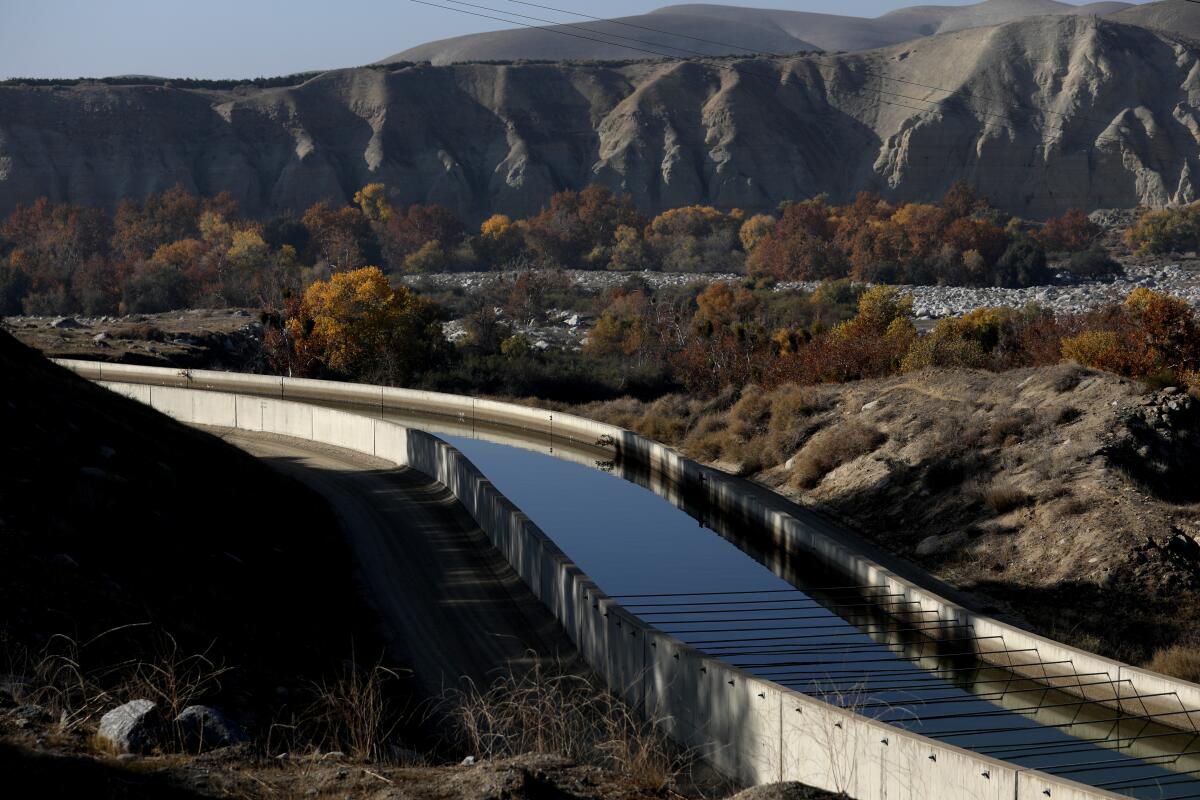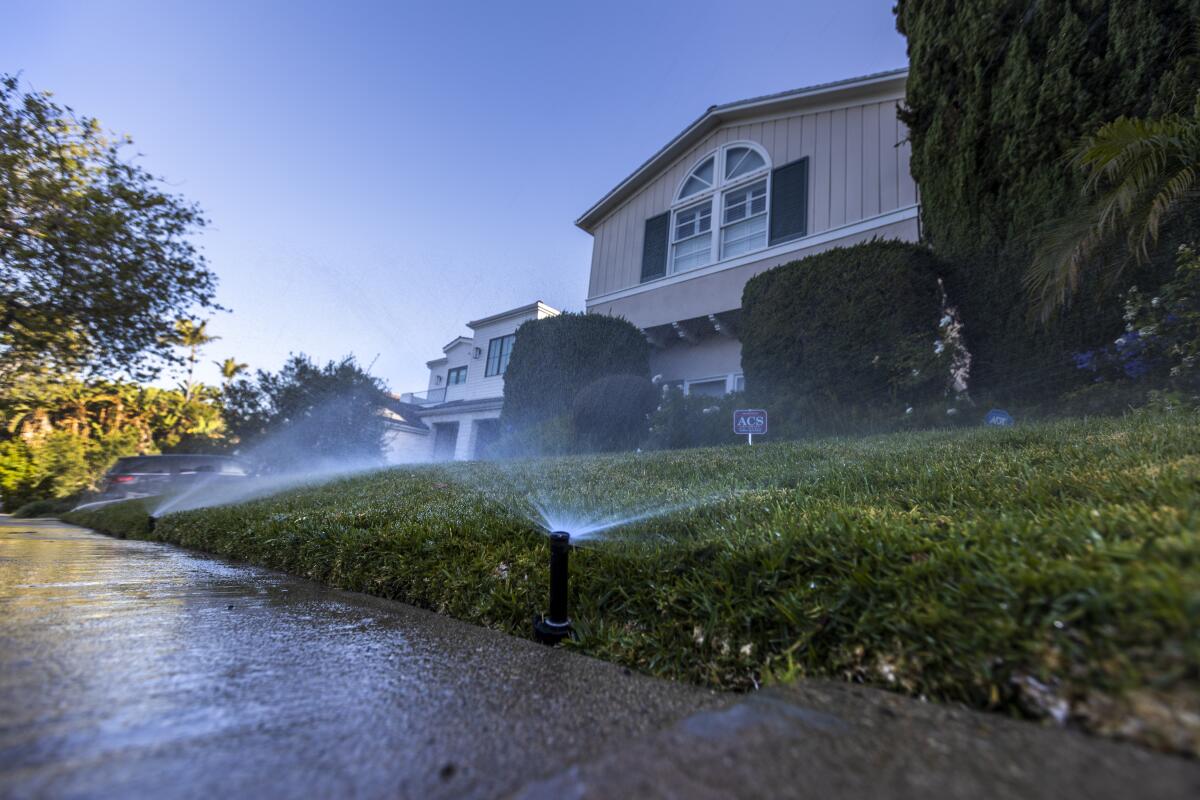Amid extreme heat, California adopts long-term water-saving targets for cities

Welcome to Boiling Point. I’m Ian James, a reporter on The Times’ climate team, writing the newsletter this week to fill in for my colleague Sammy Roth.
The blistering heat across California and the West over the last several days has been a stark reminder of how weather extremes are becoming more extreme with the burning of fossil fuels and how this demands a greater focus on adapting to rising temperatures not just today but years into the future.
Just as the heat was building last week, California officials made a major decision that will guide how urban water suppliers adapt between 2025 and 2040. The State Water Resources Control Board adopted regulations that will require suppliers in cities and towns to meet individualized water-use targets and conservation goals.
The targets under the new rules, which were required under 2018 legislation, will vary widely depending on each city’s circumstances. As my colleague Hayley Smith reports, Bakersfield will need to cut water use 25% by 2030, while the Los Angeles Department of Water and Power, which has already made significant progress on conservation, is tasked with making an initial reduction of 6% in 2035.
Like other decisions about water policy in California, the years-long process of developing the framework was controversial.
An initial proposal by the state that called for larger savings ran into strong opposition, with managers of many water agencies arguing that the proposed cuts would be costly and difficult to implement. In response, the state water board’s staff made revisions, reducing the number of suppliers required to achieve the largest cuts and extending the timeline for water reductions by five years to 2040.

Chelsea Haines of the Assn. of California Water Agencies, which represents more than 470 public agencies, said the new rules will be challenging to meet and will require a “whole statewide effort to change the way that we use water in California.” She said the additional five years will be important for achieving the long-term goals.
Leading conservation advocates, however, said the regulation that was adopted falls far short of the goals set by the state Legislature and Gov. Gavin Newsom’s water supply strategy. They pointed out that suppliers serving about 72% of Californians do not need to begin reducing water use under the rules until 2035.
Cody Phillips, an attorney for California Coastkeeper Alliance, said the board set “important and effective” long-term conservation targets, but the timeline is too long. He said the framework, formally called “Making Conservation a California Way of Life,” should instead be called “Waiting for Conservation to be a Way of Life.”
Mark Gold, director of water scarcity solutions for the Natural Resources Defense Council, said he was disappointed with the weakened requirements.
“The regulation does not meet the moment of growing water scarcity in the state of California in a timely manner,” Gold told the board. “A strong regulation will exist in 2040, but that’s 15 years from now. And there’s going to be a heck of a lot of increasing water scarcity during that time.”
Joaquin Esquivel, the water board’s chair, said the regulation isn’t perfect but represents a significant and positive change. He said it moves California in a direction “that we can all be proud of, and that is nation-leading.”
For more details about the debate and how the rules will affect various cities, check out the article by Smith.
Here’s a look at what else is happening in California and around the West.
TOP STORIES
California and much of the West have been ridiculously hot for days, with temperatures breaking daily records in cities from Fresno to Santa Rosa and reaching all-time highs in Redding, Palm Springs, Las Vegas and elsewhere. Meteorologists say the number of days with temperatures topping 100, 110 or 115 degrees has also been remarkable and dangerous. One National Weather Service meteorologist told Times reporter Grace Toohey: “We’ve had long-duration heat waves, but to have this combined with the magnitude of the heat … is unprecedented.”
Several deaths have been attributed to the extreme heat, including one motorcyclist who died while touring Death Valley National Park with a group. The temperature in the park was 128 degrees that day, and another member of the group was treated in Las Vegas for severe heat illness.
The extreme conditions follow an alarming milestone in the heating of the planet over the last year. Hayley Smith reports for The Times that June marked the 12th consecutive month of global warming at or above 1.5 degrees Celsius — the threshold that was established under the 2015 Paris accord as the target for avoiding the worst effects of climate change. Brenda Ekwurzel, a senior climate scientist with the Union of Concerned Scientists, called the unprecedented yearlong stretch disturbing, saying it’s not too late for humanity to change course, but the world needs to urgently cut emissions of greenhouse gases.
POLITICAL CLIMATE
In an earthquake of a decision last week, the Supreme Court overturned the so-called Chevron deference doctrine, a long-standing legal precedent that instructed courts to rely on federal agencies to interpret ambiguous laws. As my colleague Tony Briscoe reports, the ruling could lead to setbacks for clean air rules and other federal environmental protections by effectively stripping power from the U.S. Environmental Protection Agency and other groups. The six justices who backed the decision were appointed by Republican presidents, while those appointed by Democratic presidents dissented. Justice Elena Kagan condemned the decision, asking: “What actions can be taken to address climate change or other environmental challenges?”
Columnist Michael Hiltzik says the Supreme Court’s decision has huge implications for Americans in all walks of life. In a piece last week, he wrote: “It could subject agency decisions on scientifically based issues such as clean air and water regulations and healthcare standards to endless nitpicking by a federal judiciary that already has displayed an alarming willingness to dismiss scientific expertise out of hand, in favor of partisan or religious ideologies.”
In the maelstrom of political questions that are swirling ahead of the presidential election, one question that deserves attention is what’s at stake for action on climate change. If Donald Trump were to win, he has vowed to reverse President Biden’s climate policies and boost the oil industry. Among the first policies scrapped would likely be Biden’s executive orders aimed at dramatically increasing the number of electric vehicles and protecting 13 million acres from oil drilling in Alaska, Ella Nilsen reports for CNN. John Kerry, the president’s former special envoy for climate, said that would be “a catastrophic outcome.”
ON THE BALLOT
This November, California voters will decide on a proposed $10-billion bond measure that supporters say would help the state address impacts of climate change, including worsening droughts, floods and wildfires. My colleague Melody Petersen covered the Legislature’s approval of a bill placing the measure — the Safe Drinking Water, Wildfire Prevention, Drought Preparedness, and Clean Air Bond Act — on the ballot.
She also wrote a brief guide to the climate bond, discussing what it would do and arguments for and against it. According to the proposal, $3.8 billion would go toward providing clean drinking water, recycling wastewater, replenishing groundwater and addressing flooding, among other projects. An additional $1.5 billion would be spent on wildfire protection, and $1.2 billion would go toward protecting coastal areas from sea-level rise. Other money would be used to create parks, protect wildlife and habitats and address extreme heat events.
CALIFORNIA WILDFIRES
Wildfires are burning in California. My L.A. Times colleague Nathan Solis reported on the latest as of Monday, when crews were trying to contain the Lake fire in Santa Barbara County. The fire has grown to more than 20,000 acres in the western Los Padres National Forest, where it’s feeding on grass and brush in rugged terrain. The Times’ California wildfire map provides information about blazes throughout the state.
For some Californians, the fires are bringing traumatic memories. In a piece last week for The Times, Alex Wigglesworth interviewed a resident who snapped a picture of smoke billowing from the Thompson fire in Northern California. The 55-year-old appliance service manager said the image was eerily similar to what she saw during the Camp fire in November 2018, just before she fled her home in the town of Paradise. That blaze killed 85 people and destroyed everything Ria Abernathy owned. Reflecting on all that was lost, Abernathy said: “I think it’s really important for people to know that with the fire — the original fire — people are still struggling.”
ONE MORE THING
Extreme heat is affecting a large portion of the country’s population. As of Monday, more than 146 million Americans were under heat alerts issued by the National Weather Service, according to the federal government’s HEAT.gov website. The site for the National Integrated Heat Health Information System provides information about how to prepare and stay safe during extreme heat; it also has a map with a striking view of the large swaths of the country under excessive heat warnings.
This year, my colleague Karen Garcia wrote an article for The Times about a tool created by the federal government to help users understand how heat can affect their health, and what to do to protect themselves.
Federal officials recently proposed new measures to protect workers from extreme heat. Hayley Smith reported on the announcement by the U.S. Department of Labor’s Occupational Safety and Health Administration. The agency’s proposed rule calls for setting temperature-based standards for an estimated 35 million workers in workplaces such as warehouses, kitchens, farms and construction sites where the heat index regularly rises above 80 degrees.
The federal effort follows a similar decision in California, where a state board voted last month to adopt measures that require employers to provide cooling areas and monitor workers for signs of heat illness when indoor temperatures reach 82 degrees. My colleague Suhauna Hussain covered the new state rules, which must undergo a legal review.
While supporting these steps, some experts have criticized what they call a glaring exception in the state’s decision to exclude prisons and jails from the standards because of the cost. In an opinion article for The Times this week, Nicholas Shapiro and Bharat Jayram Venkat of UCLA said the danger of heat in California’s prisons and jails is undeniable.
“Incarcerated people are on the bleeding edge of vulnerability to climate change,” the UCLA experts wrote. “California has a moral and legal obligation to ensure that incarcerated people are protected from heat.”
This is the latest edition of Boiling Point, an email newsletter about climate change and the environment in California and the American West. You can sign up for Boiling Point here. And for more climate and environment news, follow @Sammy_Roth and @ByIanJames on X.
Toward a more sustainable California
Get Boiling Point, our newsletter exploring climate change, energy and the environment, and become part of the conversation — and the solution.
You may occasionally receive promotional content from the Los Angeles Times.




